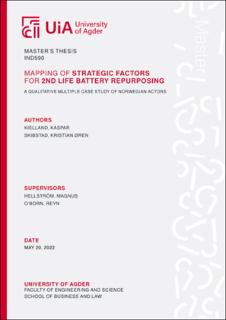| dc.description.abstract | Policies for energy efficiency and renewable energies, as well as consolidating CO2
standards for vehicles, have been implemented to achieve climate targets set by The
Paris Climate Agreement. In recent years these actions have led to a boost in the
global electrification of the transport sector, and hence Electric Vehicles (EVs). In
Norway, EVs represented a market share at 55% in 2020, making the country a
first-mover internationally.
A Lithium-Ion Batteries (LIB) is removed from the EV when the retaining capacity
drops below 80%, which will lead to an increase of decommissioned LIBs in the
future. In recent years, the amount of End of Life (EoL) batteries has been seen as a
business opportunity, giving rise to several start-ups employing decommissioned EV
batteries in second-life applications.
This thesis aims to cover a gap in the research literature, focusing on contributing
valuable insight with empirical data from the Norwegian repurpose market. Through
a qualitative multi-case study design, a selection of established businesses, either
directly or indirectly connected to the Norwegian repurpose market, were studied.
Findings mapped out strategic factors for repurposers and identified barriers and
drivers in the Norwegian repurposing market. The use case of second-life batteries,
channels for sourcing second-life batteries, and how the different cases can overcome
barriers in the market proved to be the most influential factors. Barriers within
the second-life battery market occur due to a lack of market structure and national
regulatory standards. Moreover, empirical evidence shows a need for governmental
facilitation to expand the market for second-life battery repurposing. | |
